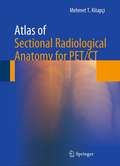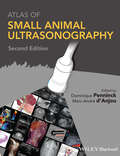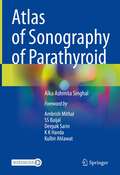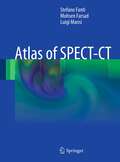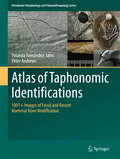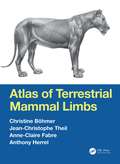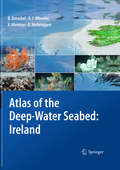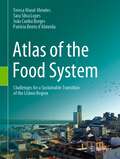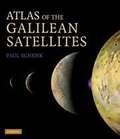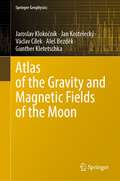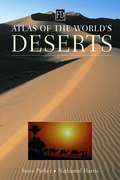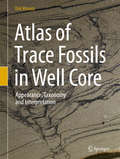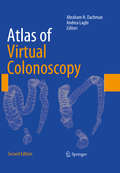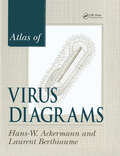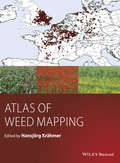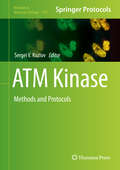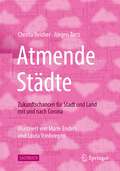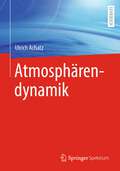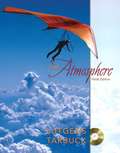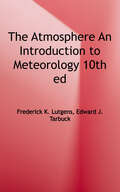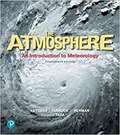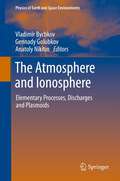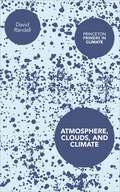- Table View
- List View
Atlas of Sectional Radiological Anatomy for PET/CT
by Mehmet T. KitapciThe horizons of sophisticated imaging have expanded with the use of combined positron emission tomography (PET) and computed tomography (CT). PET-CT has revolutionized medical imaging by adding anatomic localization to functional imaging, thus providing physicians with information that is vital for the accurate diagnosis and treatment of pathologies. Since the integration of PET and CT several years ago, PET/CT procedures are now routine at leading medical centers throughout the world. This has increased the importance of nuclear medicine physicians acquiring a broad knowledge in sectional anatomy for image interpretation. The Atlas of Sectional Radiological Anatomy for PET/CT is a user-friendly guide presenting high-resolution, full-color images of anatomical detail and focuses solely on normal FDG distribution throughout the head & neck, thorax, abdomen, and pelvis, the primary sites for cancer detection and treatment through PET/CT.
An Atlas of Selected Galaxies: With Illustrations of Photometric Analyses
by Bunshiro Takase Keiichi Kodaira Sadanori OkamuraIt is only several decades since galaxies were recognized as huge aggregations of matter in the universe which consist of myriads of stars and vast clouds of gas. The wide variety of shapes of galaxies is one of the wonders of the universe. Attempts to classify galaxies have continued since an early stage of study, when they were still called nebulae. The first step towards classification was a grouping of the patterns; the second step a systematic arrangement of various morphological types. Classification schemes that are in present use, such as Hubble's, are in the second group. These classifications are usually based on pattern recognition after a visual inspection of the photographic image of the galaxy, and is therefore qualitative and more or less subjective. Using surface photometry of galaxies, a technique which has advanced remarkably in recent years, photographs of galaxies taken in several colour bands can now be efficiently reduced to photometric data. Analysis of this data gives quantitative information on the luminosity and colour distribution for every element of galaxies. The Atlas of Selected Galaxies presents photographs taken with the Okayama 188 cm reflector and the Kiso 105 cm Schmidt telescope for the purpose of photometric analysis. A large number of illustration are given to demonstrate the way in which photographs of galaxies are reduced into quantitative data. These illustrations also show some representative results obtained in the course of the editors' work on the quantitative classification of galaxies. Part I, General Description of the Classification and Photometric Analyses, includes eight sections, whose authors all shared the photometric work and prepared the photographs. In Part II, The Atlas, the illustrations are arranged in sections corresponding to those in Part I. Part III includes tables of data for the atlas.
Atlas of Small Animal Ultrasonography
by Dominique Penninck Marc-André D'AnjouAtlas of Small Animal Ultrasonography provides a highly visual guide to the use of diagnostic ultrasound in small animal practice. This up-to-date atlas of the most commonly performed ultrasound examinations will be a valuable reference to well-established users of ultrasound as well as those just being introduced to the technology.Each chapter provides the reader with valuable information on the use of ultrasound diagnostics in small animal veterinary medicine. Taking a systems-based approach, Atlas of Small Animal Ultrasonography is divided into chapters on ultrasound procedures and techniques for examination of all major body parts and systems. Each chapter provides numerous illustrations and ultrasound images to aid the reader in diagnostic interpretation.Atlas of Small Animal Ultrasonography is an in-depth reference that provides thorough coverage of ultrasound techniques and interpretation. This volume will serve as an indispensable guide to the use of this important clinical modality.
Atlas of Sonography of Parathyroid
by Alka Ashmita SinghalThis comprehensive atlas covers various common and uncommon cases of parathyroid disorders encountered in the day to day radiological practice. It serves as an illustrative database with numerous state of the art images of the diverse imaging features of parathyroid nodules and their correlation with various other imaging modalities. The book includes videos as well. It covers the typical and atypical ultrasound features of parathyroid nodules, their color Doppler findings and Sestamibi correlation. Size of the nodules detected range from small sub-centimeter nodules measuring between 6-15 mm, where often the sestamibi scan is negative, and diagnostic ultrasound scan is quite vital in management of these cases. The larger nodules range in size to be even larger than the thyroid gland and completely compressing and displacing the thyroid gland, which often leads to a missed diagnosis on initial imaging.Chapters cover tips and tricks in scanning along with various pitfalls. Additionally, it covers parathyroid nodules diagnosed on ultrasound in Sestamibi negative cases, localization of additional parathyroid nodules and parathyroid carcinoma. It covers correlation with surgical findings and includes histopathology images where relevant. The book serves as a teaching tool for radiologists, ENT surgeons, head and neck surgeons, general surgeons, endocrinologists, nephrologists, gastroenterologists, medical oncologists and radiation oncologists involved in the management of parathyroid disorders.
Atlas of SPECT-CT
by Mohsen Farsad Stefano Fanti Luigi MansiThe field of nuclear medicine has evolved rapidly in recent years, and one very important aspect of this progress has been the introduction of hybrid imaging systems. PET-CT has already gained widespread acceptance in many clinical settings, especially within oncology, and now SPECT-CT promises to emulate its success. Useful applications of this new approach have been identified not only in oncology but also in endocrinology, cardiology, internal medicine, and other specialties. This atlas, which includes hundreds of high-quality images, is a user-friendly guide to the optimal use and interpretation of SPECT-CT. The full range of potential SPECT-CT applications in clinical routine is considered and assessed by acknowledged experts. The book is designed to serve as a reference text for both nuclear physicians and radiologists; it will also provide fundamental support for radiographers, technologists, and nuclear medicine and radiology residents.
Atlas of Taphonomic Identifications: 1001+ Images of Fossil and Recent Mammal Bone Modification (Vertebrate Paleobiology and Paleoanthropology #0)
by Peter Andrews Yolanda Fernández-JalvoThe aim of the atlas is to provide images of taphonomic modifications, making it as comprehensive as possible with evidence presently available. This volume is intended both as a field guide for identifying taphonomic modifications in the field, and for use in the laboratory when collections of fossils are being analyzed. Images in the book are a combination of scanning electron micrographs, regular photographs, cross-sections of bones and line drawings and graphs. By providing good quality illustrations of taphonomic modifications, with links between similar types of modification, the atlas provides a reference source for identifying the agents responsible for the modifications, the processes by which they were formed, and the potential bias introduced by the processes. The authors also aim to emphasize on the directions they consider taphonomic studies should be headed. Firstly, we should seek to quantify the degree of bias introduced into a fossil fauna and to take account of this bias before interpreting the palaeoecology of the fossil site. Secondly, we should recognize that taphonomic modifications increase the information encoded in fossils by identifying perimortem and postmortem context s. This provides a more dynamic and realistic view of the past.
Atlas of Terrestrial Mammal Limbs
by Christine Böhmer Jean-Christophe Theil Anne-Claire Fabre Anthony HerrelAtlas of Terrestrial Mammal Limbs is the first comprehensive and detailed anatomy book on a broad phylogenetic and ecological range of mammals. This extraordinary new work features more than 400 photographs and illustrations visualizing the limb musculature of 28 different species. Standardized views of the dissected bodies and concise text descriptions make it easy to compare the anatomy across different taxa. It provides tables of nomenclature and comparative muscle maps (schematic drawings on the origins and insertions of the muscles onto bones) in a diversity of animals. Atlas of Terrestrial Mammal Limbs is a reliable reference and an indispensable volume for all students and professional researchers in biology, paleontology, and veterinary medicine. Key Features: Provides an overview of the anatomy of the mammalian limb Includes osteological correlates of the limb muscles Illustrates anatomy in 2D Guides dissection Documents anatomical diversity in mammalian limbs Related Titles: D. L. France. Human and Nonhuman Bone Identification: A Color Atlas. (ISBN 978-1-4200-6286-1) S. N. Byers. Forensic Anthropology Laboratory Manual, 4th Edition (ISBN 978-1-1386-9073-8) S. N. Byers. Introduction to Forensic Anthropology, 5th Edition (ISBN 978-1-1381-8884-6) R. Diogo, et al. Muscles of Chordates: Development, Homologies, and Evolution (ISBN 978-1-1385-7116-7)
Atlas of the Deep-Water Seabed: Ireland
by Andrew J. Wheeler Boris Dorschel Koen Verbruggen Xavier MonteysPresented in an accessible, user-friendly format, this atlas sets out all the major features revealed during one of the largest ever deep-sea mapping campaigns. A unique insight into the morphology of the seabed along the continental margin of the North-East Atlantic, it reveals for the first time many features that have hitherto been hidden beneath the waves. It is organised both thematically and by region, with the sea floor and its biological hotspots - areas of high biodiversity such as seamounts - shown at a resolution not possible before. The atlas presents everything from submarine canyons to coral carbonate mounds, using digital terrain models generated from multibeam data and photographs taken from unmanned deep-water vehicles (ROVs). The full-colour imagery includes digital three-dimensional seabed maps as well as the photographs, with concise text descriptions and topic boxes used to highlight and explain the geological, biological and hydrographical features, in addition to their importance and context in the deep-sea realm. Alongside the wealth of background information and topic boxes on special highlights, extensive on-line resources link the reader to full data sets and GIS locations, while suggestions for further reading point to ongoing research highlights. This is a fascinating resource that will be of use to anyone involved in off-shore and underwater activities, whether scientific or commercial.
Atlas of the Food System: Challenges for a Sustainable Transition of the Lisbon Region
by Teresa Marat-Mendes Sara Silva Lopes João Cunha Borges Patrícia Bento d'AlmeidaThis book is a visual guide to the territorial dynamics operating within a territory. The reading of such dynamics is fundamental in understanding the role of food in cities. This atlas provides a refreshing approach to the study of the city and of its territory, expanded from the perspective of the food system. This book illustrates the impacts of urban planning options on the function of the contemporary Food System of the Lisbon Region, while disclosing its associated urban form solutions. It provides a possible methodology for the reading of the food system based on an analysis of planning instruments and their morphological outcomes, both in the territory but also on the various built forms which have resulted over time. A key focus of the atlas is exploring how planning has regulated the evolution of the Lisbon Region since the 20th century and its implications on the food system. The atlas results from an exhaustive survey and research work conducted in Lisbon Metropolitan Area for a research project, SPLACH – Spatial Planning for Change, for the past 3 years, in terms of the analysis of its Food System and Urban Planning, aiming to inform the delineation of planning strategies towards a sustainable urban environment. It is an important reference for planners, architects, planning and architecture students as well as municipal technicians and the general public, as it provides a refreshing and useful source of information to support further readings about the food system and its relations to urban planning instruments and urban form solutions. Furthermore, it builds a contemporary reading about possible solutions to promote a sustainable transition of the current food systems, while enhancing the strategic role of planning and urban form.
Atlas of the Galilean Satellites
by Paul SchenkComplete color global maps and high-resolution mosaics of Jupiter's four large moons - Io, Europa, Ganymede and Callisto - are compiled for the first time in this important atlas. The satellites are revealed as four visually striking and geologically diverse planetary bodies: Io's volcanic lavas and plumes and towering mountains; Europa's fissured ice surface; the craters, fractures and polar caps of Ganymede; and the giant impact basins, desiccated plains and icy pinnacles of Callisto. Featuring images taken from the recent Galileo mission, this atlas is a comprehensive mapping reference guide for researchers. It contains 65 global and regional maps, nearly 250 high-resolution mosaics, and images taken at resolutions from 500 meters to as high as 6 meters.
Atlas of the Gravity and Magnetic Fields of the Moon (Springer Geophysics)
by Jaroslav Klokočník Jan Kostelecký Václav Cílek Aleš Bezděk Gunther KletetschkaThis book presents gravity aspects (gravity disturbance, Marussi tensor, two gravity invariants, their certain ratio, the strike angles, and the virtual deformations) which are computed and evaluated for the Moon, using the recent static global gravity field model (GRGM1200A) to degree and order of 600 in spherical harmonic expansion. The magnetic anomaly model and surface topography (from the LOLA mission) are added. Results are shown for the whole Moon, for its segments around the Moon and as zooms for selected impact craters, maria and catenae; they are shortly interpreted and opened for further selenologic applications. The book contains information about the geology of the Moon, together with basic information about the magnetic field, mapping and topography models.
Atlas of the Messier Objects
by Ronald Stoyan• Simply THE most comprehensive guide to the Messier Objects ever published • Combines detailed historical, astrophysical, statistical and observing information for each object with stunning astrophotos and telescope sketches • Reproduces the text of Messier's famous catalog, along with biographies of Messier and his contemporaries • Compares modern views with historical sketches from Lord Rosse, John Herschel and other illustrious figures The 110 star clusters, nebulae and galaxies of Messier's famous catalog are among the most popular of all the deep sky objects and are beautiful targets for amateur observers of all abilities. This stunning new atlas presents a complete and lively account of all of the Messier objects. Details for each object include a thoroughly researched history of its discovery, historical observations and anecdotes, the latest scientific data detailing its astrophysical findings, and descriptions for observers to view the objects, be it with the naked eye or a large telescope. This atlas has some of the world's finest color astrophotos, labeled photos pointing to hidden details and neighboring objects, as well as historical sketches by well-known figures alongside new deep sky drawings. Quite simply, this is THE most far-reaching and beautiful reference on the Messier objects there has ever been, and one that no observer should be without!
Atlas of the World's Deserts (Ecosystems Ser.)
by Nathaniel HarrisThe Atlas of the World's Deserts examines the hostile and extreme environments that characterize deserts, and is divided into chapters that concentrate on specific aspects of a desert's geology, life forms, history, and future.For more information including sample pages, visit the Atlas of the World's Deserts web site. Also includes 160 color maps and photos.
Atlas of Trace Fossils in Well Core: Appearance, Taxonomy and Interpretation
by Dirk KnaustThis book provides the reader with a well-balanced blend of high-quality photographs, figures and accompanied text for the identification of trace fossils both in core and in outcrop. Ichnological data become more and more crucial in sedimentological and paleoenvironmental interpretations, not only in the exploration and exploitation of hydrocarbons but also in the characterization of aquifers and in scientific drilling. After an introduction to the study of trace fossils in core and an outlining of ichnological basics, principles and concepts, the book continues with a detailed description and interpretation of 39 trace fossils (ichnogenera) and associated features (such as bioturbate texture, plant roots and their traces, borings and pseudo-trace fossils) commonly encountered in well cores and in outcrop. The trace fossils are highlighted by their expression in well core, nicely illustrated with carefully prepared eye-catching core photographs. This unique information is complemented with examples of trace fossils in outcrop, as well as relevant key figures from the literature. Each description is presented in a consistent manner, stating the ichnogenus name and author in the title, followed by sections about morphology and size, ichnotaxonomy, substrate, appearance in core, similar trace fossils, producers, ethology, depositional environment, ichnofacies, age as well as reservoir quality. The book is rounded off with an extensive list of references for further reading. The material for the book originates from the author's continuous work with trace fossils in core over the last two decades.
Atlas of Virtual Colonoscopy: Comprehensive Atlas And Fundamentals
by Abraham H. Dachman Andrea LaghiAtlas of Virtual Colonoscopy thoroughly revises and updates Abraham Dachman's bestselling first edition. Joined in this edition by co-editor Andrea Laghi, Dr. Dachman has expanded the focus of the text to cover fundamental topics of this rapidly evolving technology, including the history of virtual colonoscopy, a review of clinical trial data from throughout the world, and a presentation of clinical background information. Also included are chapters covering patient preparation and tagging, performing and reporting virtual colonoscopy, viewing methods, MR colonography, and computer aided detection. The second part of the text presents an atlas of high-resolution images with detailed explanations of teaching points, covering normal anatomy; sessile, pedunculated, diminutive and flat lesions; masses; stool and diverticula; and common pitfalls. Atlas of Virtual Colonoscopy is a valuable resource for all radiologists and gastroenterologists interested in learning the fundamentals of this exciting technique.
Atlas of Virus Diagrams
by Hans-Wolfgang Ackermann Laurent BerthiaumeAuthored by electron microscopists and leading members of the International Committee on Taxonomy of Viruses (ICTV), the Atlas of Virus Diagrams includes chapters on virus classification. The diagrams, selected for content and historic and aesthetic value, illustrate vertebrate, invertebrate, and plant bacterial viruses taken from English, French, and German language virological literature. The book presents this information in three sections: Overviews, including vertebrate and plant virusesViruses with cubic and helical symmetryViruses with binary symmetry (tailed bacteriophages).
Atlas of Weed Mapping
by Hansjoerg KraehmerWeeds are variously defined as plants growing where they are not wanted, plants that interfere with human activity. Weeds affect everyone in the world by reducing crop yield and quality, delaying or interfering with harvesting, interfering with animal feeding, reducing animal health, preventing water flow, as plant parasites, etc. It is estimated that those problems cause $ billions worth of crop losses annually and the global cost of controlling weeds also runs into many $ billions every year. Atlas of Weed Mapping presents an introductory overview on the occurrence of the most common weeds of the world. The book notably includes: Description of cropping practices and explanations for the global distribution of weeds Invasive plant mapping Aquatics and wetland plants with histological plant details Theoretical and practical aspects of weed mapping Aspects on the documentation of herbicide resistance Biodiversity, rare weeds and the dominance of the most common weeds Fully illustrated with more than 800 coloured figures and a number of tables, this new characterisation of anthropogenic vegetation will be interesting for readers of a great number of disciplines such as agriculture, botany, ecology, geobotany and plant community research. More than a hundred experts have contributed data to this unique compilation.
ATM Kinase: Methods and Protocols (Methods in Molecular Biology #1599)
by Sergei V. KozlovAtaxia-telangiectasia (A-T) is a rare and severe genetic disorder affecting children. A-T is a multisystem disease characterized by progressive neurodegeneration, immunodeficiency and cancer predisposition. This detailed volume explores the ever expanding field of research into the ATM (ataxia-telangiectasia, mutated) gene and the role played by ATM kinase in DNA damage signaling and diverse cellular processes. What follows is a handy desktop reference for both seasoned A-T researchers and postgraduate students, as it demonstrates the breadth of recent developments in A-T studies. Written for the highly successful Methods in Molecular Biology series, chapters include introductions to their respective topics, lists of the necessary materials and reagents, step-by-step, readily reproducible laboratory protocols, and tips on troubleshooting and avoiding known pitfalls. Both classic and cutting-edge techniques are described, including ATM gene mutation detection, assays for radiosensitivity and radioresistant DNA synthesis, new methods to measure ATM kinase activity by imaging microscopy and high content screening as well as proteomics, phosphoproteomics and bioinformatics approaches to decipher ATM-dependent signalling pathways. Additional methods include generation of patient-specific stem cells and approaches to study ATM functions in the nervous system. Comprehensive and practical, ATM Kinase: Methods and Protocols aims to ignite and attract the interest of colleagues from diverse fields to A-T research in an effort to bring their expertise and fresh ideas to resolve many A-T puzzles still waiting to be pieced together and to alleviate the suffering of A-T children and their families.
Atmende Städte: Zukunftschancen für Stadt und Land mit und nach Corona
by Christa Reicher Jürgen TietzDie dramatische Sars-CoV-2 Pandemie wirkt weltweit in vielen Bereichen des Lebens wie ein Brandbeschleuniger. Davon sind auch Architektur und Städtebau betroffen. Der Handel in den Innenstädten ist weggebrochen, die Bedeutung von Büros nimmt ab. Dafür werden mehr Grünflächen für die Erholung benötigt und veränderte Wohnungsgrundrisse, um das Homeoffice aufzunehmen. Das Buch benennt die wichtigsten architektonischen und städtebaulichen Veränderungen, die mit Corona in Stadt und Land einhergehen, stellt sie in den Kontext des Stadtumbaus durch den Klimawandel, verortet sie historisch und leitet daraus konkrete Strategien und Chancen ab, um den zentralen Zukunftsherausforderungen zu begegnen, die sich aus der Pandemie für Stadt und Land ergeben.
Atmosphärendynamik
by Ulrich AchatzDieses Lehrbuch richtet sich an Studierende der Meteorologie sowie an Forschende zu theoretischen und numerischen Aspekten von Wetter und Klima. Der vorliegende Text konzentriert sich auf das Wesentliche und bleibt dabei gleichermaßen gründlich. Alle zum Verständnis notwendigen physikalischen Konzepte werden eingeführt.Einleitend erfolgt eine Herleitung der Grundgleichungen der Atmosphärendynamik. Diese werden nachfolgend herangezogen, um wesentliche Aspekte von Wetter und Klima zu erläutern, zu denen unter anderem die Mechanismen hinter den wirbelartigen Bewegungen auf der täglichen Wetterkarte gehören. Als Mittel zu einer effizienten Analyse von atmosphärischen Wellen folgt die Vereinfachung der Dynamik mithilfe der Flachwassergleichungen. Daraufhin wird unter Zuhilfenahme der quasigeostrophischen Theorie das Auftreten extratropischer Wettersysteme begründet. Dem schließt sich eine ausführliche Betrachtung der globalen atmosphärischen Zirkulation an, die maßgeblich dem Einfluss durch Rossby- und Schwerewellen unterliegt. Auch die spezifischen Eigenschaften der atmosphärischen Grenzschicht werden diskutiert. Im Mittelpunkt steht hier die Wechselwirkung zwischen Turbulenz und mittlerer Strömung.Im Zuge der Betrachtungen wird die Leserschaft mit wesentlichen theoretischen Konzepten des Gebiets vertraut gemacht. Hierzu zählen Entropie und potentielle Temperatur, potentielle Vorticity, Instabilitätstheorie, Reynoldsgleichungen, Mehrskalenasymptotik, WKB-Theorie, Wellenwirkung, Eliassen-Palm-Fluss, transformiertes Eulermittel, kritische Schichten, Wellenbeugung und vieles mehr.Der Text wird durch Anhänge zu mathematischen Methoden und weiteren Vertiefungen ergänzt. Kapitelzusammenfassungen helfen, den Blick auf das Wesentliche zu bewahren. Ergänzende Leseempfehlungen regen dazu an, das erworbene Wissen zu vertiefen und zu erweitern.
The Atmosphere: An Introduction to Meteorology (9th edition)
by Frederick K. Lutgens Edward J. TarbuckA standard textbook presenting a current and comprehensive survey of meteorology for undergraduates.
The Atmosphere: An Introduction to Meteorology
by Frederick K. Lutgens Edward J. TarbuckUsing everyday, easy-to-grasp examples to reinforce basic concepts, this highly regarded handbook remains the standard introduction to meteorology and the atmosphere – components, problems, and applications. Includes the most up-to-date coverage of topics such as: ozone depletion; the ultraviolet index; temperature; dew point temperature and orographic effects; wildfires and weather; thunderstorms and lightning; the record-breaking Florida hurricane season; effects of air pollution, and more. Incorporates top-quality visuals, including new satellite images and illustrations by the award-winning Dennis Tasa, to demonstrate the highly visual nature of meteorology. Uses a largely non-technical writing style to help readers grasp important concepts. For those interested in learning more about meteorology.
The Atmosphere: An Introduction to Meteorology
by Frederick Lutgens Edward Tarbuck Redina Herman Dennis TasaThe Atmosphere: An Introduction to Meteorology remains the definitive introductory meteorology text, reinforcing basic concepts with easy-to-grasp, everyday examples. Authors Tarbuck and Lutgens present meteorology with a friendly, largely non-technical narrative, timely coverage of recent atmospheric events, and carefully crafted artwork by leading science illustrator Dennis Tasa. The 14th Edition includes a new, easier-to-navigate design, and a more reader-oriented approach that provides a clear learning path throughout the text. New pedagogical improvements, including pull quotes that act as guideposts, end-of-chapter questions and problems, and online exercises and activities, are available in Mastering™ Meteorology to help readers understand the processes that control our weather and apply this information in their daily lives.
The Atmosphere and Ionosphere
by Anatoly Nikitin Gennady Golubkov Vladimir BychkovThe main topics of the book are the analysis of reactions in the atmosphere-ionosphere system and the influence of natural and technogenic processes on them. The book also examines a range of related research from an international field. In all, five sections of the volume cover the dynamics of atmospheric aerosols; the dynamics of an ionosphere and atmosphere and their communication through an ionosphere; elementary processes in the upper atmosphere and an ionosphere; electromagnetic and optical phenomena in atmosphere, including long-lived and plasma objects; and Information systems of environment monitoring and prevention of incidents. The primary goals of the text are to reveal the interrelations of the dynamics of various atmospheric layers, as well as discovering the parameters of the atmosphere and ionosphere and establishing the role of various physical factors in the phenomena. The aim is to forecast the dynamics of environment in the development of external perturbations.
Atmosphere, Clouds, and Climate (Princeton Primers in Climate #6)
by David RandallAn essential primer on atmospheric processes and their important role in the climate systemThe atmosphere is critical to climate change. It can amplify shifts in the climate system, and also mitigate them. This primer offers a short, reader-friendly introduction to these atmospheric processes and how they work, written by a leading expert on the subject.Giving readers an overview of key atmospheric processes, David Randall looks at how our climate system receives energy from the sun and sheds it by emitting infrared radiation back into space. The atmosphere regulates these radiative energy flows and transports energy through weather systems such as thunderstorms, monsoons, hurricanes, and winter storms. Randall explains how these processes work, and also how precipitation, cloud formation, and other phase changes of water strongly influence weather and climate. He discusses how atmospheric feedbacks affect climate change, how the large-scale atmospheric circulation works, how predicting the weather and the climate are fundamentally different challenges, and much more. This is the ideal introduction for students and nonspecialists. No prior experience in atmospheric science is needed, only basic college physics.Authoritative and concise, Atmosphere, Clouds, and Climate features a glossary of terms, suggestions for further reading, and easy-to-follow explanations of a few key equations. This accessible primer is the essential introduction to atmospheric processes and the vital role they play in our climate system.
